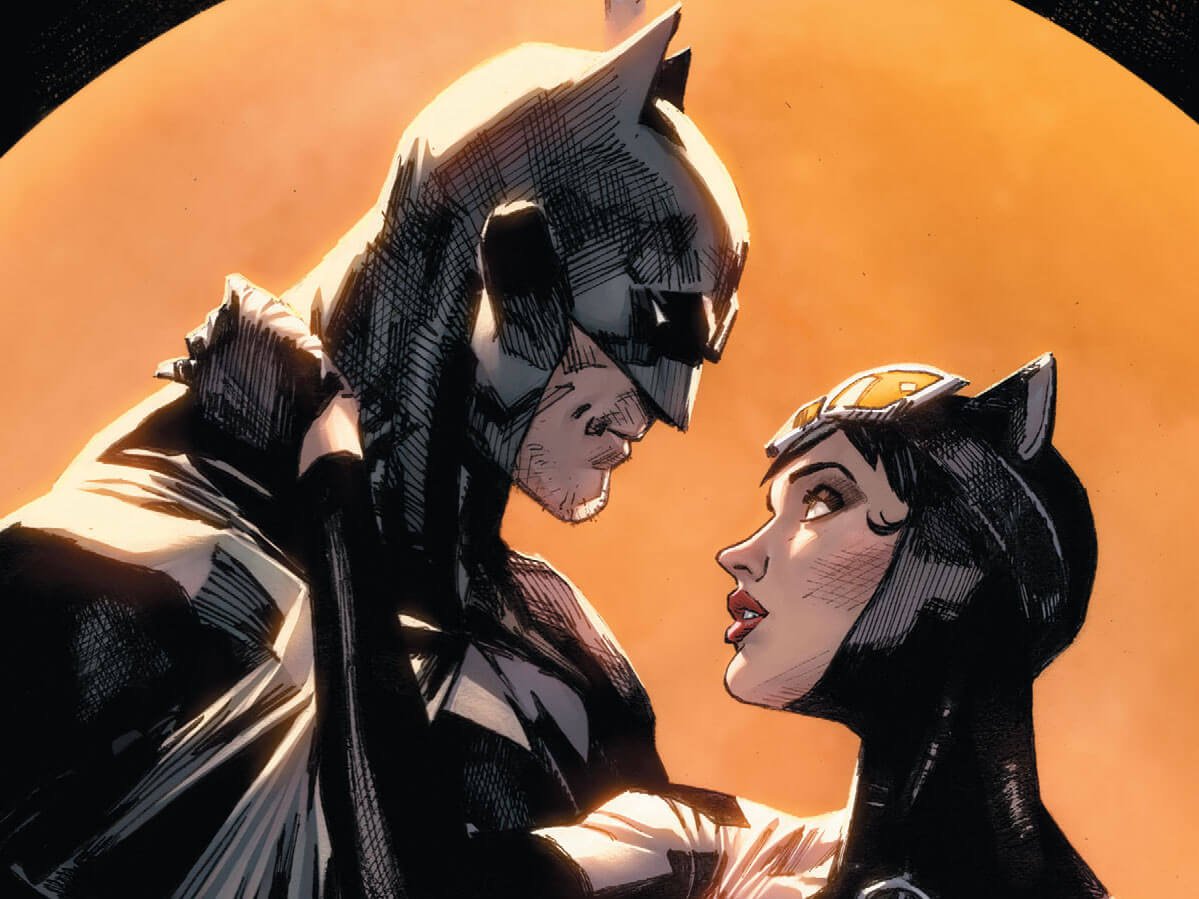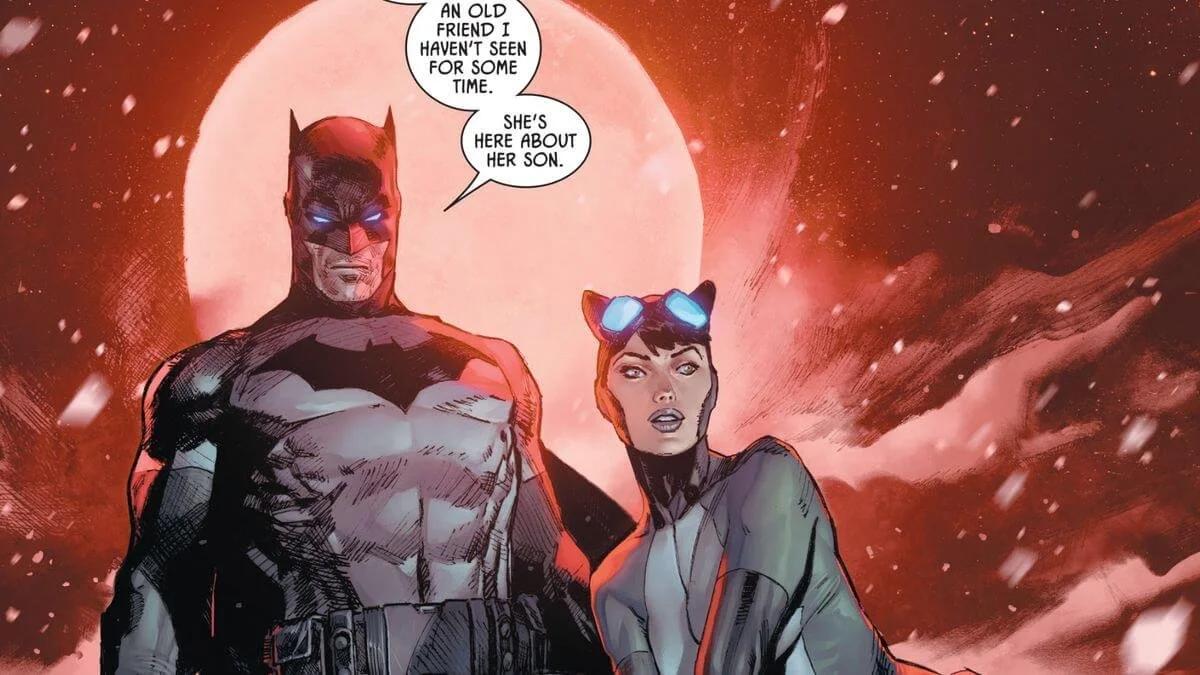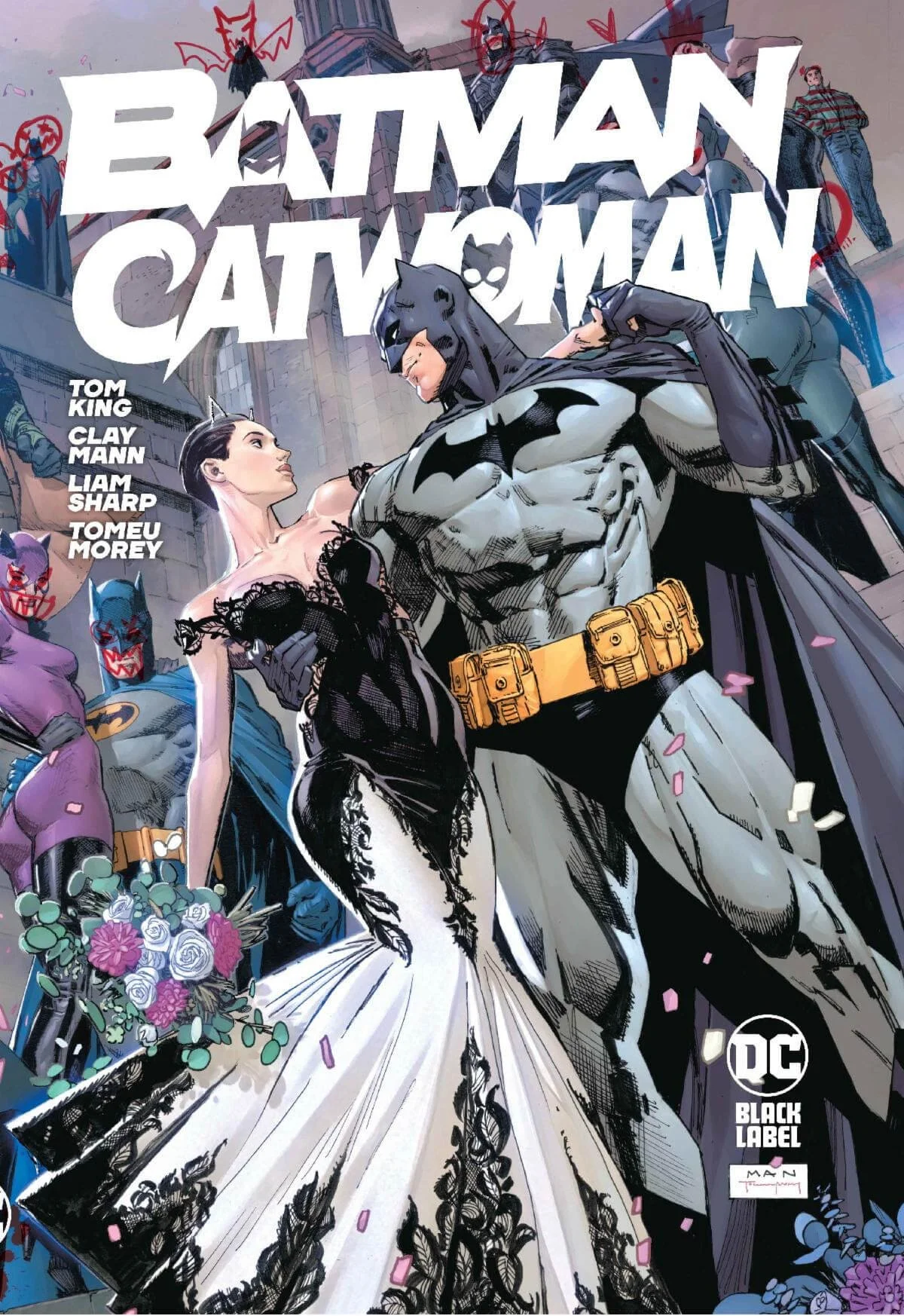Writer: Tom King Pencillers: Clay Mann (#1 - #6, #10 - #12) / Liam Sharp (#7 - #9) John Paul Leon, Bernard Chang, Shawn Crystal, Mitch Gérards (Christmas Special) / Colour Artists: Tomeu Morey, Dave Stewart * / Letterer: Clayton Cowles /
*Note: some artists colour their own work on the Christmas special along with Liam Sharp for his issues.
Collects: Batman/Catwoman #1-#12, Batman/Catwoman Special, Batman Annual #2, Catwoman 80th Anniversary 100-Page Super Spectacular #1, Detective Comics #1027.
5th December 2022 (Released: 14th December 2022)
Review by Paul Dunne
The Pitch: The Bat and the Cat’s past, present, and future collide in a thrilling and romantic epic from a superstar creative team! Tom King returns to the rocky, romantic saga of Batman and Catwoman with his frequent collaborator, superstar artist Clay Mann. Echoing plot points from King’s epic Batman run, this sweeping tale is told across three timelines: the past, when the Bat and the Cat first fell in love; the present, where their union is threatened by one of Batman’s lost loves; and the future, where the couple has a happy life and legacy—including their daughter Helena, the Batwoman. As the story begins, after a long marriage, Bruce Wayne passes away—which frees Selina Kyle to settle an old score. At every stage of their relationship, Bruce and Selina have an unwelcome chaperone: The Joker! Oh, and that lost love of Bruce’s? It’s Andrea Beaumont, a.k.a. Phantasm. Just thought you’d want to know.
Can comic book heroes ever really have happy endings? Like addicts who remain addicts, no matter how long their sobriety, once the hook of heroism is in them, can they ever really get over their motivating traumas long enough to find a measure of solace? This idea seems to obsess Tom King. It's there in Mister Miracle. In The Vision. Heroes in Crisis... And it's there in spades in his Batman run, which seemed to divide readers in much the same way Dan Slott's ASM run had: they all knew it was good writing but some of them couldn't decide if they loved it or hated it, so hating it became easier. Personally (and this will not shock the vast majority of you), I loved it. The measured pacing. The reinvention of previously unusable characters (Kite Man!). And yeah, the misery. I've been at this comic reading game a long time and I can tell you I know two things: comics should be fun...
And your fun may not be the same as mine. Don't get me wrong. I don't revel in misery. But I don't mind it as an adjunct to putting characters in a healthier mental and dramatic space. That is to say, pain is sometimes necessary. And no one does emotional trauma better than the Bat and the Cat. We're talking about two people so fucked up that they call each other by their made-up names when they're in bed and by their real names when they're in costume. Maybe they really are made for each other. There's strange stuff at work here and a lot to acclimatise to. First is the pacing. King moves at his own speed which can sometimes be frustrating. The second is the structure. Taking his cue from Dickens' Christmas Carol, King presents us with Ghosts of Christmas past, present, and future. Those ghosts wear different faces at different times... But they're all one person: The Joker. More like a poltergeist than a foreboding spirit, he arrives to break and destroy, singing merry carols on the way. And then another face is added to the repertoire of Christmas past: Andrea Beaumont, The Phantasm. Like Selina, she sees a solution for Gotham’s problems, one that is vastly at odds with Bruce’s. All three time-frames are marked by death, including Bruce's, which makes the future passages the most interesting of all, giving you a Batman book without Batman... It's really Selina's book anyway. Her game dictates the shape of the story. Her motivations are a mystery, at times even to the reader. At one stage, they flummoxed this reviewer so much that he had to retrace his steps. Like Grant Morrison's Batman R. I. P., this plays better as one extended book rather than a series of issues. And you're better polishing it off in one or two sittings, getting an idea of Selina’s long game.
The mood of the whole thing is somewhat tragic. This really does feel like the last Batman story, with the great crescendo played not as Gottemdamurang but as the Allegretto from Beethoven's 7th. A little joy, a little sadness, a little whimsy, but so much atmosphere. Clay Mann's pencils in the first half of the series are controlled and detailed. There's an austere feeling to them, like everyone in the panel are dueling opponents, choosing their pistols, ready to deliver fatal shots. His style is clean and clear, something I'm grateful for as the book switches time frames mid-page more often than not. It’s a gorgeous-looking book. The sadness in the story seems to have been echoed in the real lives of its creators, as Mann took ill midway through the book's schedule and John Paul Leon passed away suddenly. You feel those losses. Looking through the Christmas Special is a rewarding and wounding experience. Leon's work astounds (as does Mann's), although he's more comfortable in the shadows than Mann is. The special is a pleasing breather (I placed it in singles around issue #10, so I'm curious to see where it gets placed in the final print version of the HC). It propels us even further into the pasts of the characters, providing an insight into what and who made them who they are. Other artists also provide work for this issue, creating a smooth patchwork of visual styles that blend nicely. Bernard Chang, Mitch Gérads, and Shawn Crystal all create top-notch penciling for the issue.
None of this is to say that Liam Sharp, who fills in for Mann on the issues he was unable to complete, does a bad job. In fact, because Sharp is working on a look we've not seen from him, it immediately catches your eye. The style is dynamic, itching to get your eye across the page. There's a frantic movement to much of it, which makes a nice contrast to Mann's more centered, still pencils. He also embraces the darkness of vision more readily, which works well with the pitch and tone of the story at this point. Yes, we trade Mann's elegance for Sharp's more pugilistic-looking Bruce, but a bloody fight is what you expect from a comic at this stage. Mann returns for the final issues and closes the story wonderfully, getting King's bittersweet moments to play nicely on the page. Tomeu Morey's colours on Mann's pencils are crisp and clear, never muddying the line. I cannot even begin to tell you what this does for the tonal and chronological shifts of the story and how much it aids them. And a round of hearty applause and a glass of egg nog should go to Clayton Cowles, whose lettering captures the weariness of Bruce's doomed love for Selina and her cut crystal taunting. A beautiful close to King's Batman run, only managing to stealth its happy ending in, thanks to the juxtaposition of time frames. Like Bruce's disintegrating mind, it plays with hope, happiness, and misery. It may be fascinating one day to see this book broken up and reconstituted by time frame. Until then, enjoy the whirl of the romance, the crushing heartbreak of losing and gaining your one true love, and of course, have a merry Christmas, even if you're alone.
Batman Catwoman is available in HC from your local comic book store on 13th December 2022 (US) and 14th December 2022 UK & Europe).





